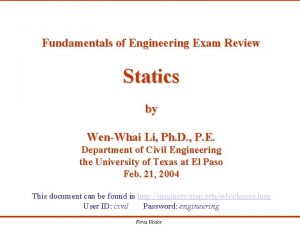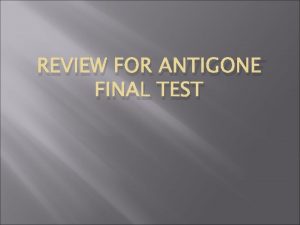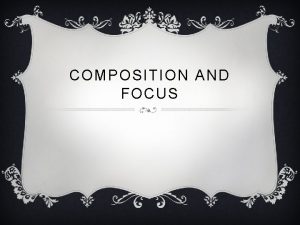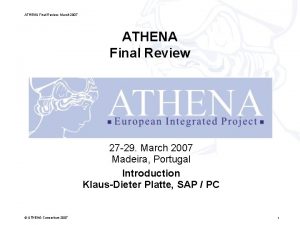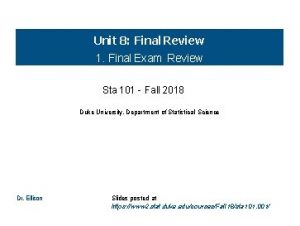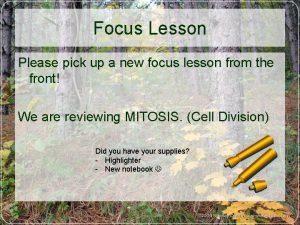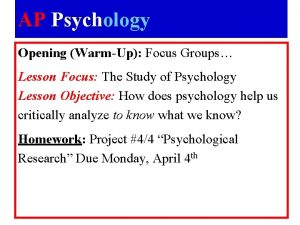Focus Lesson Complete this REVIEW Complete the final








































- Slides: 40

Focus Lesson: Complete this REVIEW Complete the final portion of this focus lesson. Have to complete definitions or examples? DO IT NOW!

What are we learning? LAST CLASS TODAY Notes: Hominid Evolution Pg 37 � Practice: • Darwin Explanation Page 38 • Skull Trends Page 39 � � Vocabulary Reference Sheet � UNIT 4 REVIEW Corrections DUE March 11 th � � � Notes: Classification Page 41 Name that Kingdom! Page 40 FIX YOUR NOTEBOOK • If we can finish early, if you are on task, and if there are no behavior issues you can use this time to catch up on your notebook or flashcards.

What do we need to know for the EOC? Only 23 Classes away! SWBAT describe the system used to classify life on earth. - Cell Structure - Mode of Nutrition - Cell Type

Page 41: Kingdoms and Domains �How would you classify this organism?

The Three-Domain System �The tree of life is divided into 3 domains and within the domains are 6 kingdoms. �Domain Bacteria – corresponds to the Kingdom Eubacteria �Domain Archaea – corresponds to the Kingdom Archaebacteria �Domain Eukarya – composed of the Kingdoms Plantae, Animalia, Fungi and Protista

Domain Archaea �Members of the domain Archaea are unicellular prokaryotes. �They live in extreme environments �Their cell walls lack peptidoglycan.

Domain Bacteria � Members of the Domain Bacteria are unicellular prokaryotes. – Their cells have thick, rigid cell walls that surround a cell & contains peptidoglycan. – one of largest groups on Earth – classified by shape, need for oxygen, and diseases caused

Bacteria and Archaea can be difficult to classify. – Transfer genes among themselves outside of reproduction – blurs the line between “species” – more research needed to understand prokaryotes bridge to transfer DNA

Domain Eukarya � The domain Eukarya consists of organisms that have a nucleus. � (Eukaryotes) � This domain is organized into four kingdoms: • • Protista Fungi Plantae Animalia

Domain/Kingdoms Within the 3 domains there are 6 kingdoms.

The 6 Kingdoms �Archaebacteria �Eubacteria �Protista �Fungi Prokaryotes (unicellular) �Plantae Eukaryotes (Most �Animalia are Multicellular)

The Big Picture

Kingdom Archaebacteria �“Ancient bacteria”- • Live in very harsh environments • Extremophiles �Unicellular Prokaryotes �Autotroph or Heterotroph �Cell Walls without peptidoglycan

Archaea

Kingdom Eubacteria � It is the eubacteria that most people are talking about when they say bacteria, because they live in more neutral conditions.

Eubacteria

Kingdom Protista � Protists include many widely ranging microbes, including slime molds, protozoa and primitive algae. � There animal-like, fungus-like, and plant-like protists • (Some are photosynthetic) � Some protists can cause diseases in humans, such as malaria and dysentery

Kingdom Fungi � The Kingdom Fungi includes some of the most important organisms. � By breaking down dead organic material, they continue the cycle of nutrients through ecosystems � They are multicellular filaments that absorb nutrients. � Some are multicellular and some are unicellular like yeast.

Kingdom Plantae � All plants are multicellular, their cells having a cell wall. � they are autotrophs (Make own food through photosynthesis)

Kingdom Animalia � All animals are: - Multicellular: cells lacking a cell wall -Heterotrophs - Capable of movement at some point in their lives.

Eukarya


Top Half of Page 40: Name that Kingdom 1. 2. 3. 4. Your group is going to get an envelope which contains an unknown organism. Paste your organism into your notebook. Use your graphic organizer, and the clues given to identify the organism’s Domain and Kingdom. Explain your reasoning.

�Which Domain and Kingdom does this fit in? Stats: – heterotroph – single-celled

�Which Domain and Kingdom does this fit in? Stats: – heterotroph – multi-celled

�Which Domain and Kingdom does this fit in? Stats: – Autotroph – Multi Celled

�Which Domain and Kingdom does this fit in? Stats: – Heterotroph – Multi Celled

�Which Domain and Kingdom does this fit in? Stats: Single Celled Unusual Cell Wall Lives in Extreme Environments Some hot springs bacteria can tolerate temperatures up to 88°C (190°F) and acidities as low as p. H 0. 9. One species, Thermoplasma, may be related to the ancestor of the nucleus and cytoplasm of the more advanced eukaryote cells.

Independent Practice: Page 40 Bonus Round A. If you come across an unusual single-celled organism, what parts of the cell would you study in order to classify it into one of the 3 domains? A. Explain why it is difficult to classify some bacteria and Archaea from each other. B. Why is the classification of life considered a work in progress?

Page 42: Classifying with Cladograms

Classification: The evolutionary relationship between organisms

Cladograms Scientist use cladograms to show these relationships with a diagram. A cladogram is an evolutionary tree that proposes how species may be related through common ancestors. As organisms change and adapt new characteristics over time new branches are added to the tree.

How can we tell if species are related even if they appear different? Classifications are determined by many pieces of evidence: �Living species traits and behaviors �The fossil record �Molecular data �DNA sequence similarities

• • The closer organisms = more related. The further away organisms = less related.

According to this phylogenic tree, which organism is most closely related to humans? � Answer: Mouse


Derived Characters �Cladograms are organized by traits. �Derived characters are traits that are shared by some species but not by others. Let’s try using transportation as an example. Transportation “Species”: Bicycle, car, motorcycle, airplane, on foot.

Let’s try making our own! Derived Lamprey Character Vertebrae X Jaws Bones Four Limbs Amniotic Egg Feathers Shark Swordfish X X X Frog X X Alligator X X X Gull X X X

Your Turn! Create a Cladogram to illustrate these characteristics on Page 42 Derived Character Backbone Lungs Claws/nails Hair Opposable thumbs Fully bipedal Fish Salamander Lizard Mouse Ape X X X X Human X X X Predict: Which organism has the fewest nucleotide sequence similarities to humans? EXPLAIN. (What is a nucleotide? )

Home Learning: Page 43 �Complete the handout as home learning to prepare for your test on Evolution. • WARNING! There may be questions on Genetics on this test as well. Study your entire Quarter 3 Notebook. • NO EXCUSES JUST AWESOMENESS. #YOLO
 Uncontrollable spending ap gov
Uncontrollable spending ap gov Language
Language Porters strategies
Porters strategies Differentiation cost leadership
Differentiation cost leadership Actor focus vs object focus
Actor focus vs object focus Final focus template
Final focus template Lesson 4 gravity and motion lesson review
Lesson 4 gravity and motion lesson review This lesson will focus
This lesson will focus Lesson 6 language focus
Lesson 6 language focus World history spring final exam review answers
World history spring final exam review answers World history and geography final exam study guide
World history and geography final exam study guide Spanish final exam review packet answer key
Spanish final exam review packet answer key Pltw human body systems final exam
Pltw human body systems final exam Poe practice test kinematics answers
Poe practice test kinematics answers Ied final exam review
Ied final exam review World history semester 2 final review packet
World history semester 2 final review packet World history b semester exam review practice
World history b semester exam review practice Entrepreneurship 1 final exam review
Entrepreneurship 1 final exam review Spanish 2 final exam review packet
Spanish 2 final exam review packet Earth science final exam review
Earth science final exam review Ap world history jeopardy review game
Ap world history jeopardy review game Us history semester 2 review
Us history semester 2 review Final exam review algebra 1
Final exam review algebra 1 Geometry final review
Geometry final review English 4 semester 2 exam
English 4 semester 2 exam Physics fall final exam review
Physics fall final exam review Hft 2401 exam 1
Hft 2401 exam 1 Fe exam statics
Fe exam statics Symbols for john proctor
Symbols for john proctor Physical science final exam
Physical science final exam Mat 1033 final exam review
Mat 1033 final exam review Zoology semester 1 exam review answers
Zoology semester 1 exam review answers Lna
Lna Chemistry fall semester exam review answers
Chemistry fall semester exam review answers Earth science final
Earth science final Apes semester 1 final exam
Apes semester 1 final exam Us history semester 1 final exam study guide answers
Us history semester 1 final exam study guide answers Spanish 1 final exam
Spanish 1 final exam Personal finance final exam review
Personal finance final exam review Antigone open-ended questions
Antigone open-ended questions Psyc 1504 final exam
Psyc 1504 final exam



























